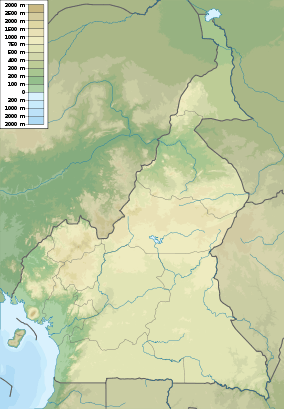Shum Laka
| Shum Laka | |
|---|---|
 Shum Laka Archaeological Site | |
| Coordinates | 5°51′31″N 10°4′40″E / 5.85861°N 10.07778°ECoordinates: 5°51′31″N 10°4′40″E / 5.85861°N 10.07778°E |
| Official name: Site archéologique de Shum Laka | |
| Type | Tentative, Cultural |
| Criteria | iii, iv |
| Designated | 2006 [1] |
| Reference no. | 4014 [1] |
| State | Cameroon |
| Region | List of World Heritage Sites in Africa |
| Occupation | 32,000-800 BP |
The archaeological site of Shum Laka is the most prominent rockshelter site in the Grasslands region of the Laka Valley, northwest Cameroon. Occupations at this rockshelter date to the Later Stone Age.[2] This region is important to investigations of the development and subsequent diffusion of the Bantu culture.[3] The site of Shum Laka is located approximately 15 kilometers from the town of Bamenda, and it resides on the inner wall of the Bafochu Mbu caldera.[4] The deposits at Shum Laka include each phase of cultural development in the Grasslands.[3]
Geoarchaeology of Shum Laka
The rockshelter itself at Shum Laka is approximately 50 meters wide at its greatest point and 20 meters deep.[5] Stratigraphic dating of surface and near surface deposits support occupations as early as 30,000 BP.[6] Geomorphological analysis determined that the rockshelter had been subjected to alluvial depositional events during the Holocene, but archaeological deposits remained mostly intact and in situ.[7] Fluvial erosional processes at the site were determined to have had their greatest impact laterally, and thus not damaged contextual integrity between cultural occupations.[5] The importance of geoarchaeological investigations conducted at Shum Laka includes the construction of a reliable cultural chronology of the area, and an emphasis on the need to critically evaluate other rockshelter sites in the region.[5]
Archaeological deposits
At Shum Laka, over 1,000 ceramic sherds, nearly 500,000 pieces of lithic materials, and 18 human skeletons were recovered.[3] Radiocarbon dating of the bone and plant remains recovered demonstrated multiple occupations spanning from 30,000 BP to around 400 BP.[3][6] Bone preservation from the early occupations is poor, with only a few surviving faunal remains and no bone tools.[2] Later occupations depict common exploitation of medium-sized fauna from the forest.[8] These remains include those from several gorillas and chimpanzees, and various artiodactyla.[8] Based upon the small amounts of materials found in individual strata, it is proposed that the site was occupied for numerous short periods of time.[3] Macrobotanical remains recovered included both savanna grasses and forest trees. These indicate that for a period of occupation during the Holocene, Shum Laka was located within an ecotone.[3] Ceramic assemblages recovered from the site date from 7000 BP onward and are indicative of continued longer occupation by semi-agricultural populations.[3] Additionally, these ceramic assemblages indicate the use of the rockshelter by different groups of peoples and that these people interacted with various western African states.[3]
Lithic assemblage and environmental variability
The lithic assemblage in some of the late Pleistocene occupations at Shum Laka are unique in the presence of a quartz industry early than most other sites in the region.[6] The presence of a microlithic quartz industry at Shum Laka, when combined with supporting evidence from other rockshelter and late Pleistocene sites in the Grasslands, is indicative of a more mobile population that exploited a variety of resources in the ecotonal landscape.[6] This behavioral strategy is ascribed as an adaptation to common regional environmental changes during the late Pleistocene.[6] It is well established that the late Pleistocene in northern Cameroon and the surrounding area was highly variable climatically.[2] Particularly during the Last Glacial Maximum, refuge occupations by people would have been short-term and highly variable based on rapid, localized changes.[2] Similar lithic assemblages and strategies as those found at Shum Laka have been delineated at other rockshelter sites in the area dating to the same period.[2]
World Heritage status
This site was added to the UNESCO World Heritage Tentative List on April 18, 2006 in the Cultural category.[9]
Notes
- 1 2 http://whc.unesco.org/en/tentativelists/4014/
- 1 2 3 4 5 Cornelissen, Els (2002) Human Responses to Changing Environments in Central Africa Between 40,000 and 12,000 B.P. Journal of World Prehistory 16(3):197-235.
- 1 2 3 4 5 6 7 8 Lavachery, Philippe (2001) The Holocene Archaeological Sequence of Shum Laka Rock Shelter (Grasslands, Western Cameroon). African Archaeological Review 18(4):213-247.
- ↑ Willoughby, Pamela (2006) The Evolution of Modern Humans in Africa: A Comprehensive Guide, Rowman Altamira.
- 1 2 3 Lavachery, Philippe and Els Cornelissen (2000) Natural and Cultural Spatial Patterning in the Late Holocene Deposits of Shum Laka Rock Shelter, Cameroon. Journal of Field Archaeology 27(2):153-168.
- 1 2 3 4 5 Cornelissen, Els (2003) On Microlithic Quartz Industries at the End of the Pleistocene in Central Africa: The Evidence from Shum Laka (NW Cameroon). African Archaeological Review 20(1):1-24.
- ↑ Moeyersons, Jan (1997) Geomorphological Processes and their Palaeoenvironmental Significance at the Shum Laka cave (Bamenda, Western Cameroon). Palaeogeography, Palaeoclimatology, Palaeoecology 133:103-116.
- 1 2 de Maret, Pierre, Bernard Clist, and Wim Van Neer (1987) Resultats des premieres fouilles dans les abris de Shum Laka et D'Abeke au nord-ouest du Cameroun. L'Anthropologie 91(2):559-584.
- ↑ Site archéologique de Shum Laka - UNESCO World Heritage Centre